“Flighting” Golf Shafts
Altering tip trimming to create different flexes
Before we touch upon our topic of “flighting” golf shafts, when need to first look back at last week’s article where we showed you how certain shafts can be trimmed in multiple ways to create alternative flexes. This process allows club fitters greater latitude in producing in-between or custom flexes for their clientele. In the case of the KBS Tour, you saw one shaft could be used to create a range of flexes and in some cases this produces flex overlap.
| Flex | FCM Range |
| R | 4.0 - 5.5 |
| S | 5.0 - 6.5 |
| X | 6.0 - 7.5 |
For instance, if you wanted the equivalent of a 5.5 flex, you could elect to take the R or the S flex shaft and then follow the appropriate trimming table as we will show shortly. While the X flex range may appear too stiff to create a 5.5 flex, I am going to let you onto a little secret. Actually it is no secret at all, we are just applying the principles we learned in the previous article. We know in order to create a 6.0 flex we would take the X-flex blank and use the following trim chart.

Using the Principles in Reverse
One of the questions you may ask in the back of your mind is how many golfers still use a 1 or 2 iron (or even hybrid) anymore? The answer is few. So what if we started with the 3-iron and took 1” less off of the tip than what is suggested? We learned that cutting 1” additionally increased the FCM level by 0.5 (5 cpm) or ½ flex. Therefore, if the opposite would occur by leaving an extra inch from the tip, we should see a reduction in the FCM level from 6.0 to 5.5. Now we have three different shafts that could literally produce the exact same frequency numbers and slope.

Concept of “Flighting” a golf shaft
Just because we produced the same frequency numbers, does this mean we produced the exact same stiffness? The answer to this is a big “NO” and here is the reason why. A golf shaft is a hollowed tapered tube. This stiffness is defined by many parameters such as the weight, wall thickness and outside diameters of the shaft. One of those parameters you can see quickly on a stepped steel shaft is the distance of the parallel tip section or the distance to the first step.

The raw, uncut R-flex KBS Tour shaft had a parallel tip section of 12”, the S-flex 11.5” and the X-flex 10.5”. However, if we followed the trimming instructions from the previous chart, you will notice how the parallel tip section changes. While the R-flex appeared to have the longest parallel tip section, after our aggressive tip trimming to increase the stiffness to the 5.5 FCM level, we have much less parallel tip section remaining as this chart will show.

On the other end of the spectrum, the X-flex blank had the least amount of parallel tip section in the raw, uncut form. However, we opted to tip trim less off of the shaft to create a softer (5.5) frequency level. Here’s the skinny, if you have two similar geometry shafts with the same frequency, then the one with a shorter parallel tip section should provide a lower trajectory as the tip will be stiffer. Conversely, a longer parallel tip section with very similar geometries will produce a softer tipped section and subsequently a higher launch angle.
This is how “Flighted” shafts are produced to be able to offer higher launching shaft in the long irons for ease of play, mid launching in the mid-irons and lower launch in the scoring clubs by a manipulation in tip trimming of different flex blanks. Some may say these have progressive bend or kick point, but it is really manipulating the parallel tip section that is creating these changes.
Limitations to flighting golf shafts
You cannot "flight" with any unitized, parallel tipped shaft. Rather, the manufacturer has to produce a series of blanks that are nearly identical other than the raw, uncut frequency (stiffness) and possibly weight. Few manufacturers are going to do this because of cost and the reason why these types of shaft demand a higher selling price.
This is a good exercise in understanding the effects of tip trimming on shafts and how you create differences is initial ball flight or trajectory. Secondly, this is one reason why you might see an R-flex shaft create a higher ball flight versus the same exact shaft in S-flex. Lastly, this illustrates why two clubs of the same length and frequency (stiffness) don’t always play or feel the same.
